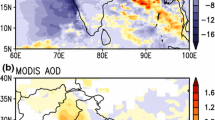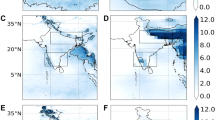Abstract
Climate-aerosol model ECHAM5-HAM is employed to study effects of aerosol air pollution on rainfall in southern Africa. Aerosols effect the climate through light scattering and absorption, modification of cloud properties, and other indirect effects. The simulation model simulates the global climate on a grid and aerosol emissions from all major economic sectors as provided by the GAINS emission model. Using different model setups, we can separate the effect of aerosol light absorption due to black carbon and other aerosols, that of aerosols interacting with clouds through acting as cloud condensation nuclei and that through the ocean response. This is the first study of its kind to employ aerosol station measurements for model validation. Comparisons are done with previous plentiful studies for south Asia with many similarities in aerosol and rainfall climatology. We conclude that aerosols likely have a weak, negative effect on rainfall with internal variability dominating the simulation results, consistently with observed historical records. Aerosol light absorption does not seem to have a strong impact on rainfall. Meanwhile, the complexity of the problem also leaves uncertainty to the results. Regionally, the results show an opposite pattern of greenhouse gas projections that suggest a wet-get-wetter and dry-get-drier development due to global warming.








Similar content being viewed by others
References
Beukes JP, Vakkari V, Van Zyl PG, Venter AD, Josipovic M, Jaars K, Tiita P, Siebert S, Pienaar JJ, Kulmala M, Laakso L (2013) Welgegund: long-term land atmosphere measurement platform in South Africa. iLeaps Newsletter 12:24–25
Chiloane KE, Beukes JP, van Zyl PG, Maritz P, Vakkari V, Josipovic M, Venter AD, Jaars K, Tiitta P, Kulmala M, Wiedensohler A, Liousse C, Mkhatshwa GV, Ramandh A, Laakso L (2017) Spatial, temporal and source contribution assessments of black carbon over the northern interior of South Africa. Atmos Chem Phys 17:6177–6196. https://doi.org/10.5194/acp-17-6177-2017
Collett K, Piketh S, Ross K (2010) An assessment of the atmospheric nitrogen budget on the south African Highveld. S Afr J Sci 106. https://doi.org/10.4102/sajs.v106i5/6.220
Collins M, Knutti R, Arblaster J, Dufresne J-L, Fichefet T, Friedlingstein P, Gao X, Gutowski WJ, Johns T, Krinner G, Shongwe M, Tebaldi C, Weaver AJ, Wehner M (2013) Long-term climate change: projections, commitments and irreversibility in: climate change 2013: the physical science basis. In: Stocker TF, Qin D, Plattner G-K, Tignor M, Allen SK, Boschung J, Nauels A, Xia Y, Bex V, Midgley PM (eds) Contribution of working GroupI to the fifth assessment report of the intergovernmental panel on climate change. Cambridge University Press, Cambridge, United Kingdom and New York, NY
Dee DP, Uppala SM, Simmons AJ, Berrisford P, Poli P, Kobayashi S, Andrae U, Balmaseda MA, Balsamo G, Bauer P, Bechtold P, Beljaars ACM, van de Berg L, Bidlot J, Bormann N, Delsol C, Dragani R, Fuentes M, Geer AJ, Haimberger L, Healy SB, Hersbach H, Hólm EV, Isaksen L, Kållberg P, Köhler M, Matricardi M, McNally AP, Monge-Sanz BM, Morcrette J-J, Park B-K, Peubey C, de Rosnay P, Tavolato C, ThépautJ-N, Vitart F (2011) The ERA-interim reanalysis: configuration and performance of the data assimilation system Q.J.R. Meteorol Soc 137:553–597. https://doi.org/10.1002/qj.828
Ganguly D, Rasch PJ, Wang H, Yoon J-H (2012a) Climate response of the south Asianmonsoon system to anthropogenic aerosols. J Geophys Res 117:D13209. https://doi.org/10.1029/2012JD017508
Ganguly D, Rasch PJ, Wang H, Yoon J-H (2012b) Fast and slow responses of the south Asian monsoon system to anthropogenic aerosols. Geophys Res Lett 39:L18804. https://doi.org/10.1029/2012GL053043
Giglio L, Randerson JT, van der Werf GR, Kasibhatla PS, Collatz GJ, Morton DC, DeFries RS (2010) Assessing variability and long-term trends in burned area by merging multiple satellite fire products. Biogeosciences 7:1171–1186. https://doi.org/10.5194/bg-7-1171-2010
Henriksson SV, Laaksonen A, Kerminen V-M, Räisänen P, Järvinen H, Sundström A-M, de Leeuw G (2011) Spatial distributions and seasonal cycles of aerosols in India and China seen in global climate-aerosol model. Atmos Chem Phys 11:7975–7990. https://doi.org/10.5194/acp-11-7975-2011
Henriksson SV, Pietikäinen J-P, Hyvärinen A-P, Räisänen P, Kupiainen K, Tonttila J, Hooda R, Lihavainen H, O'Donnell D, Backman L, Klimont Z, Laaksonen A (2014) Spatial distributions and seasonal cycles of aerosol climate effects in India seen in a global climate–aerosol model. Atmos Chem Phys 14:10177–10192. https://doi.org/10.5194/acp-14-10177-2014
Kim KM, Lau WKM, Sud YC, Walker GK (2010) Influence of aerosol-radiative forcings on the diurnal and seasonal cycles of rainfall over West Africa and eastern Atlantic Ocean using GCM simulations. Clim Dyn 35:115–126. https://doi.org/10.1007/s00382-010-0750-1
Kim MK, Lau WKM, Kim KM, Sang J, Kim YH, Lee WS (2016) Amplification of ENSO effects on Indian summer monsoon by absorbing aerosols. Clim Dyn 46:2657–2671. https://doi.org/10.1007/s00382-015-2722-y
Klimont Z, Cofala J, Xing J, Wei W, Zhang C, Wang S, Kejun J, Bhandari P, Mathur R, Purohit P, Rafaj P, Chambers A, Amann M, Hao J (2009) Projections of SO2, NOx and carbonaceous aerosols emissions in Asia. Tellus 61B:602–617
Kumar V, Jain SK, Singh Y (2010) Analysis of long-term rainfall trends in India. Hydrol Sci J 55(4):484–496. https://doi.org/10.1080/02626667.2010.481373
Lau WKM, Kim K-M (2010) Fingerprinting the impacts of aerosols on longterm trends of the Indian summer monsoon regional rainfall. Geophys Res Lett 37:L16705. https://doi.org/10.1029/2010GL043255
Lau KM, Kim MK, Kim K-M (2006) Aerosol induced anomalies in the Asian summer monsoon: the role of the Tibetan plateau. Clim Dynam 26:855–864. https://doi.org/10.1007/s00382-006-0114-z
Levy RC, Mattoo S, Munchak LA, Remer LA, Sayer AM, Patadia F, Hsu NC (2013) The collection 6 MODIS aerosol products over land and ocean. Atmos Meas Tech 6:2989–3034
Lin H, Leaitch WR (1997) Development of an in-cloud aerosol activation parameterization for climate modelling. Proceedings of the WMO Workshop on Measurement of Cloud Properties for Forecasts of Weather, Air Quality and Climate, Mexico City, June, 328–335
Marsland SJ, Haak H, Jungclaus JH, Latif M, Roske F (2003) The max-Planck-institute global ocean/sea ice model with orthogonal curvilinear coordinates. Ocean Model 5:91–127
Monteiro A, Sá E, Fernandes A, Gama C, Sorte S, Borrego C, Lopes M, Russo MA (2018a) How healthy will be the air quality in 2050? Air Qual Atmos Health 11:353–362. https://doi.org/10.1007/s11869-017-0466-z
Monteiro A, Sá E, Fernandes A, Gama C, Sorte S, Borrego C, Lopes M, Russo MA (2018b) Correction to: How healthy will be the air quality in 2050? Air Qual Atmos Health 11:363. https://doi.org/10.1007/s11869-018-0569-1
Piketh SJ, Annegarn HJ, Tyson PD (1999) Lower tropospheric aerosol loadings over South Africa: the relative contribution of aeolian dust, industrial emissions, and biomass burning. J Geophys Res 104(D1):1597–1607. https://doi.org/10.1029/1998JD100014
Preston-Whyte RA, Tyson PD (2000) The weather and climate of southern Africa. Oxford university press, Oxford
Ramanathan V, Chung C, Kim D, Bettge T, Buja L, Kiehl JT, Washington WM, Fu Q, Sikka DR, Wild M (2005) Atmospheric brown clouds: impact on south Asian climate and hydrologic cycle. P Natl Acad Sci USA 102:5326–5333. https://doi.org/10.1073/pnas.0500656102
Ramanathan V, Li F, Ramana MV, Praveen PS, Kim D, Corrigan CE, Nguyen H, Stone EA, Schauer JJ, Carmichael GR, Adhikary B, Yoon SC (2007) Atmospheric brown clouds: hemispherical and regional variations in long-range transport, absorption and radiative forcing. J Geophys Res 112:D22S2. https://doi.org/10.1029/2006JD008124
Randles CA, Ramaswamy V (2010) Direct and semi-direct impacts of absorbing biomass burning aerosol on the climate of southern Africa: a geophysical fluid dynamics laboratory GCM sensitivity study. Atmos Chem Phys 10:9819–9831. https://doi.org/10.5194/acp-10-9819-2010
Roberts G, Wooster MJ, Lagoudakis E (2009) Annual and diurnal african biomass burning temporal dynamics. Biogeosciences 6:849–866
Roeckner E, Bäuml G, Bonaventura L, Brokopf R, Esch M, Giorgetta M, Hagemann S, Kirchner I, Kornblueh L, Manzini E, Rhodin A, Schlese U, Schulzweida U, Tompkins A (2003) The atmospheric general circulation modelECHAM5. Part I: Model description, Report 349, Max Planck Institute for Meteorology, Hamburg, Germany, available at: http://www.mpimet.mpg.de/fileadmin/publikationen/Reportsmax_scirep_349.pdf. Last access: 18 September 2014.
Roeckner E, Brokopf R, Esch M, Giorgetta M, Hagemann S, Kornblueh L, Manzini E, Schlese U, Schulzweida U (2006a) Sensitivity of simulated climate to horizontal and vertical resolution in the ECHAM5 atmosphere model. J Clim 19:3771–3791
Roeckner E, Stier P, Feichter J, Kloster S, Esch M, Fischer-Bruns I (2006b) Impact of carbonaceous aerosol emissions on regional climate change. Clim Dynam 27:553–571
Sakaeda N, Wood R, Rasch PJ (2011) Direct and semidirect aerosol effects of southern African biomass burning aerosol. J Geophys Res 116:D12205. https://doi.org/10.1029/2010JD015540
Samset BH, Myhre G, Schulz M, Balkanski Y, Bauer S, Berntsen TK, Bian H, Bellouin N, Diehl T, Easter RC, Ghan SJ, Iversen T, Kinne S, Kirkevåg A, Lamarque J-F, Lin G, Liu X, Penner JE, Seland Ø, Skeie RB, Stier P, Takemura T, Tsigaridis K, Zhang K (2013) Black carbon vertical profiles strongly affect its radiative forcing uncertainty. Atmos Chem Phys 13:2423–2434. https://doi.org/10.5194/acp-13-2423-2013
Stier P, Feichter J, Kinne S, Kloster S, Vignati E, Wilson J, Ganzeveld L, Tegen I, Werner M, Balkanski Y, Schulz M, Boucher O, Minikin A, Petzold A (2005) The aerosol-climate model ECHAM5-HAM. Atmos Chem Phys 5:1125–1156. https://doi.org/10.5194/acp-5-1125-2005
Tesfaye T, Botai J, Sivakumar V, Mengistu Tsidu G (2013) “Evaluation of regional climatic model simulated aerosol optical properties over South Africa using ground-based and satellite observations,” ISRN atmospheric sciences, article ID 237483, 17 pages. https://doi.org/10.1155/2013/237483.
Tesfaye M, Botai J, Sivakumar V, Tsidu GM (2014) Simulation of biomass burning aerosols mass distributions and their direct and semi-direct effects over South Africa using a regional climate model. Meteorog Atmos Phys 125:177–195
Tuinstra W (2007) Preparing for the European thematic strategy on air pollution: at the interface between science and policy. Environ Sci Pol 10:434–444
Vakkari V, Beukes JP, Laakso H, Mabaso D, Pienaar JJ, Kulmala M, Laakso L (2013) Long-term observations of aerosol size distributions in semi-clean and polluted savannah in South Africa. Atmos Chem Phys 13:1751–1770. https://doi.org/10.5194/acp-13-1751-2013
Vignati E, Wilson J, Stier P (2004) M7: a size resolved aerosol mixture module for the use in global aerosol models. J Geophys Res 109(D22):202. https://doi.org/10.1029/2003JD004485
Wang C, Kim D, Ekman AML, Barth MC, Rasch PJ (2009) Impact of anthropogenic aerosols on Indian summer monsoon. Geophys Res Lett 36:L21704. https://doi.org/10.1029/2009GL040114
Acknowledgements
We thank the Max Planck Institute for Meteorology for providing us with the climate-aerosol model. The exact version used was ECHAM5.3.01-HAM1.5. We acknowledge Zbignew Klimont and Kaarle Kupiainen from IIASA for providing us with the emission data produced with the GAINS model.
Author information
Authors and Affiliations
Corresponding author
Rights and permissions
About this article
Cite this article
Henriksson, S., Sundström, AM., Josipovic, M. et al. Simulating effects of aerosols on rainfall in southern Africa. Air Qual Atmos Health 12, 1–10 (2019). https://doi.org/10.1007/s11869-018-0619-8
Received:
Accepted:
Published:
Issue Date:
DOI: https://doi.org/10.1007/s11869-018-0619-8




